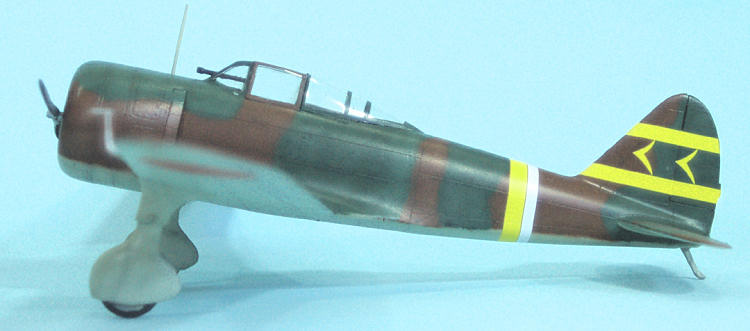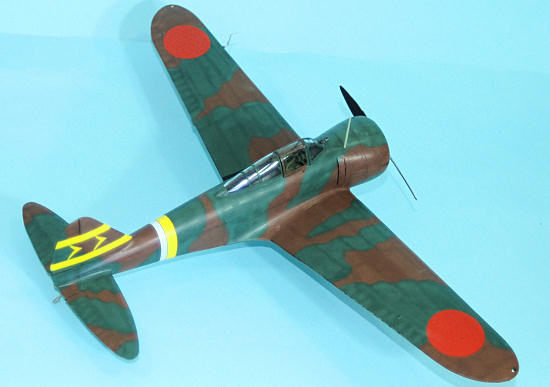Special Hobby 1/32 Ki-27 otsu
|
KIT #: |
32040 |
|
PRICE: |
5,280 yen at
www.hlj.com |
|
DECALS: |
Three options |
|
REVIEWER: |
Tom Cleaver |
|
NOTES: |
Includes resin and photo etched parts |

Most fighter pilots prior to 1936 were technological conservatives who
valued high‑g close‑in maneuverability in their biplane fighters more than they
did the speed and armament increase possible with the all‑metal monoplane.
Perhaps no fighter pilots in the world were more conservative in this
area than those of the Japanese Army Air Force, who were taught to compare
themselves with the ancient Kendo masters, and to use the maneuverability
of their aircraft in the same way that the Kendo master wielded his
Shinai. Thus, when Koku Hombu ‑ the Air H.Q. of the Imperial Army ‑
issued their requirements for an "advanced fighter" in 1935, the primary goal
was to graft the most desirable characteristics of the biplane onto a monoplane.
The IJN had previously issued a similar requirement, which resulted in
the 9‑Shi fighter, known to the IJN as the A5M, and to history as the "Claude"
fighter; Mitsubishi entered a modified A5M type, known as the Ki.33, in the
competition. But for the JAAF, even
 this
outstandingly maneuverable monoplane was not maneuverable enough.
this
outstandingly maneuverable monoplane was not maneuverable enough.
Chief Designer Tei Koyama of Nakajima created a design that was even more
exacting in terms of weight control than what Jiro Horikoshi at Mitsubishi had
achieved with the A5M, representing the smallest possible airframe that could be
designed around the Nakajima Kotobuki‑II Kai, a license built version of
the Bristol Jupiter. The prototype,
designated the Ki.27, first flew on October 15, 1936. When flown in competition
with the Mitsubishi Ki.33 and the
Kawasaki
Ki.28, the Ki.27 displayed noteworthy superiority as regarded maneuverability.
At a weight of only 2,866 lb., it had a wing loading of 14.33 lb/square foot, it
had a clear edge in close‑in high‑g combat maneuvering over its competitors. The
new warplane retained all the agility of the Ki.10 it was intended to replace,
yet offered major advances in speed and climb performance.
A trio of pre‑production Ki‑27s were assigned to the 1st Chutai of
the 2nd Hiko‑Datai in northern
China
in March, 1938. On
April 10, 1938,
the well known JAAF ace Captain Tateo Kato, 1st
Chutai
CO,
claimed the destruction of three Chinese flown I‑152s on his first mission.
On April 15, the trio ‑ accompanied by 12 Ki.10s ‑ fought a pitched
battle with 30 I‑152s over
Shanxi,
with Japanese claims of 24 out of 30.
After this, the Chinese fighters were pulled back out of range of their
new Japanese opponents. Despite the
fact that the range and firepower of the Ki.27 even at the outset of its combat
career was shown to be below that of the international standard, Koku Hombu
made no move to try and improve the Ki.27, which was in fact an airframe that
was so specialized it had no growth potential. Lacking range to escort bombers,
the Ki.27 did not again see combat for a number of months.
On
April 20, 1939,
the Ki.27 suffered its first combat losses in combat against Soviet flown I‑152s
over
Nanking.
A month later, the Nomonhan "incident" ‑ a three month war between the
Imperial Japanese Army and the
Soviet Union
‑ began.
 Within two weeks of Mongolian cavalry crossing into
Manchuria
on
May 11, 1939,
fighting escalated to aerial combat. On May 22, six patrolling Ki.27s
encountered six I‑16s and shot down three. On
May 28, 60
I‑16s and I‑152s were intercepted by 18 Ki‑27s, who claimed 51 of the Soviet
fighters without loss. On
June 22, 1939,
the 24th Sentai claimed 54 of 60 I‑16s, against a loss of 4 Ki.27s.
These claims were due to the vast difference between the highly trained
Japanese pilots and their haphazardly trained Soviet opponents.
Throughout the Nomonhan Incident, JAAF fighters consistently maintained a
margin of aerial superiority.
Within two weeks of Mongolian cavalry crossing into
Manchuria
on
May 11, 1939,
fighting escalated to aerial combat. On May 22, six patrolling Ki.27s
encountered six I‑16s and shot down three. On
May 28, 60
I‑16s and I‑152s were intercepted by 18 Ki‑27s, who claimed 51 of the Soviet
fighters without loss. On
June 22, 1939,
the 24th Sentai claimed 54 of 60 I‑16s, against a loss of 4 Ki.27s.
These claims were due to the vast difference between the highly trained
Japanese pilots and their haphazardly trained Soviet opponents.
Throughout the Nomonhan Incident, JAAF fighters consistently maintained a
margin of aerial superiority.
Shortcomings in the Ki.27 revealed in the Nomonhan incident were not
corrected, since they resulted in adverse effects on performance of the fighter.
In September, 1940, Nakajima was ordered to phase out production of the Ki.27 in
favor of its successor, the Ki.43.
Production was continued at the Mansyu plant in
Harbin,
Manchuria,
until July 1942.
Outside of two Sentais equipped with the Ki.43‑I‑Ko and one
independent Chutai equipped with the pre‑production Ki.44, the JAAF
entered the Pacific War still equipped with the Ki.27 as its major fighter.
The extreme maneuverability of the fighter gave British pilots over
Malaya fits, but the pilots of the American Volunteer Group, fighting over
Rangoon, discovered that one good burst of their two .50 caliber machine guns
was sufficient to explode the completely‑ unprotected Ki.27.
Diving on the Japanese fighters, the AVG's P‑40s could attack and dive
away in the knowledge that the lightweight Ki.27 could not keep up with them.
The 77th Sentai formed two‑thirds of the Japanese fighters the Flying
Tigers fought over Burma in the first months of 1942; to this day, one risks
complete ostracism if they inform a veteran of the AVG that they did not in fact
fight "Claudes" and "Zeros" over Rangoon, but rather "Nates" and "Oscars."
By the end of 1942, the Ki.27 only equipped units assigned to defense of
the
Home
Islands.
The kit comes on five sprues of limited-run injection-molded parts with
engraved detail, a small bag of resin parts and a small photo-etch fret. Decals
are provided for three aircraft with different field applications of camouflage
as seen in the later stages of the
Malaya
and
Burma
campaigns in January-March 1942.
Bill Koppos did a
great review
of the Ki.27-ko kit and this kit is essentially that kit, using the
different rear canopy section.
Since Bill did such a good job of finding all the land mines in this kit,
I followed his review, and you should too, if you do this kit.
Since this model was headed for display at Planes of Fame, behind a glass
door at least three feet from the viewer, I did not go into the detail Bill did
with his contest model, and decided to close u p
the canopy and preserve the external lines of the model.
I note that my research for the interior color found information at
j-aircraft.com that “Nakajima Interior Color” as it applies to Japanese Army Air
Force aircraft is a more yellow version of their Navy Interior Color, which is
essentially Interior Green. I mixed
some Tamiya “cockpit color” with “yellow chromate” and got what might be right.
No one who looks at it is going to know.
Bill's blue cockpit may be right too.
p
the canopy and preserve the external lines of the model.
I note that my research for the interior color found information at
j-aircraft.com that “Nakajima Interior Color” as it applies to Japanese Army Air
Force aircraft is a more yellow version of their Navy Interior Color, which is
essentially Interior Green. I mixed
some Tamiya “cockpit color” with “yellow chromate” and got what might be right.
No one who looks at it is going to know.
Bill's blue cockpit may be right too.
Overall, as Bill pointed out, assembly is easy, and it was even easier
for me since I followed the rule “if you can't see it, I didn't do it.” This
applied to the engine, most of which is invisible behind the oil cooler once
inside the cowling, and the cockpit, which is almost invisible with the canopy
closed. The fit of the lower wing
to the fuselage is fine everywhere except at the front area behind the cowling,
where I got a “step” I couldn't get rid of no matter how much of this and that I
trimmed. I ended up using a lot of
Squadron Green Putty, then Tamiya Surfacer, and then rescribing that area.
Just remember that the motto at Special Hobby is: “Fit?
Fit?! We don't need no
steenking fit, steenking Yanqui!!” (To paraphrase the famous line in Treasure
of the Sierra Madre)
 I decided to do the airplane on the box art, which was flown by
13-victory ace Captain Toshiro Kowabara, commander of the 3rd
Chutai of 77th Sentai, the main opponents of the AVG over
Burma.
I painted the underside with Tamiya “J.a. Grey,” and the upper surfaces
with Tamiya “NATO Brown” and “Deep Green,” which looked about right in
comparison with the color profile.
I decided to do the airplane on the box art, which was flown by
13-victory ace Captain Toshiro Kowabara, commander of the 3rd
Chutai of 77th Sentai, the main opponents of the AVG over
Burma.
I painted the underside with Tamiya “J.a. Grey,” and the upper surfaces
with Tamiya “NATO Brown” and “Deep Green,” which looked about right in
comparison with the color profile.
The kit decals went on perfectly under a coat of Micro-Sol and I was glad
to see that the yellow markings were sufficiently opaque to cover the colors
beneath the decal.
 I decided to let the airplane look like it might have shortly after
receiving its field-applied camouflage, and did not ding it.
I then realized that I had managed to feed the resin exhausts to the
carpet monster (I'm sure he found them a tasty treat).
Oh well. Their absence won't
be noticed where this model will sit, but you should take care to keep those
little resin parts inside the kit box during your project.
Think of the women and children, man!
They don't need to hear all that “purple prose.”
I decided to let the airplane look like it might have shortly after
receiving its field-applied camouflage, and did not ding it.
I then realized that I had managed to feed the resin exhausts to the
carpet monster (I'm sure he found them a tasty treat).
Oh well. Their absence won't
be noticed where this model will sit, but you should take care to keep those
little resin parts inside the kit box during your project.
Think of the women and children, man!
They don't need to hear all that “purple prose.”
As Bill Koppos demonstrated, you can create a show-stopper with this kit,
with only a bit of “some modeling skill required.”
My model will look just fine sitting there in the glass case next to
those Hasegawa JAAF fighters. Yours
can look even better.
Tom Cleaver
November 2011
Thanks to
HobbyLink Japan for the review
kit.
If you would like your product reviewed fairly and fairly quickly, please contact the editor or see other details in the
Note to
Contributors.
Back to the Main Page
Back to the Review
Index Page


 this
outstandingly maneuverable monoplane was not maneuverable enough.
this
outstandingly maneuverable monoplane was not maneuverable enough. 


